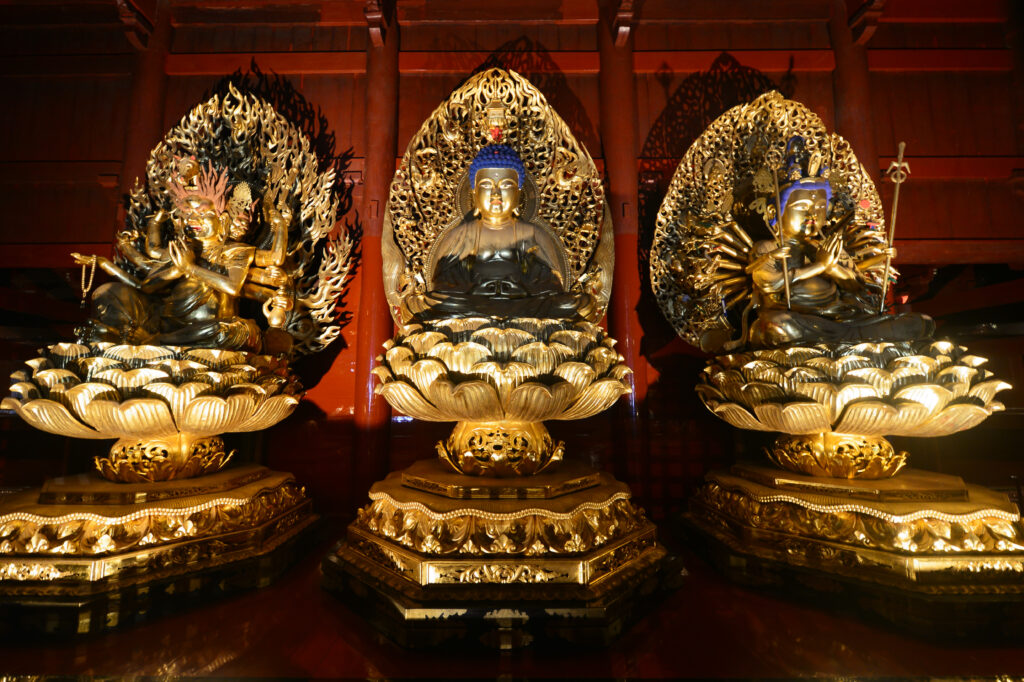
On December 2, 1999, the “Shrines and Temples of Nikko” were registered as a World Heritage Site at the 23rd session of the World Heritage Committee held in Marrakech, Morocco.
The “Shrines and Temples of Nikko” on the World Heritage List consists of 103 buildings (9 National Treasures and 94 Important Cultural Properties) of the Futaarasan Shrine, Toshogu Shrine, and Rinnoji Temple located in the mountains of Nikko, and the “ruins (cultural landscape)” surrounding these structures.
Among the most celebrated of these national treasures and important cultural properties are:
Nikko Toshogu
Nikko Toshogu Shrine is dedicated to Tokugawa Ieyasu, the first Tokugawa Shogun, and was established in 1617. The significance of this shrine is that it established order and organization after so many turbulent years of civil war, promoted learning and industry, and laid the foundation for peace and refined culture—prompting 260 years of the peaceful Edo period. This is the turning point of Japanese history and culture and contributed greatly to the development of modern Japan known around the world today.
The Supreme Shogun
Tokugawa Ieyasu passed away at Sunpu Castle (Shizuoka City, Shizuoka Prefecture) on April 17, 1616, at the age of 73.
According to his will, the shrine was moved from Kunouzan to its current location one year later, and dedicated to the deification of Ieyasu. The shrine was then named Toshogu Shrine in 1645. Over the years, the Toshogu Shrine has been meticulous maintained to retain its original style and splendor.
Besides the primary shrine, there has been construction of 55 buildings, including the Yomeimon Gate (a national treasure), cost 568,000 “ryo” of gold, 100 “kan-monme” of silver, and 1,000 “koku” of rice, or 40 billion yen in today’s monetary estimations.
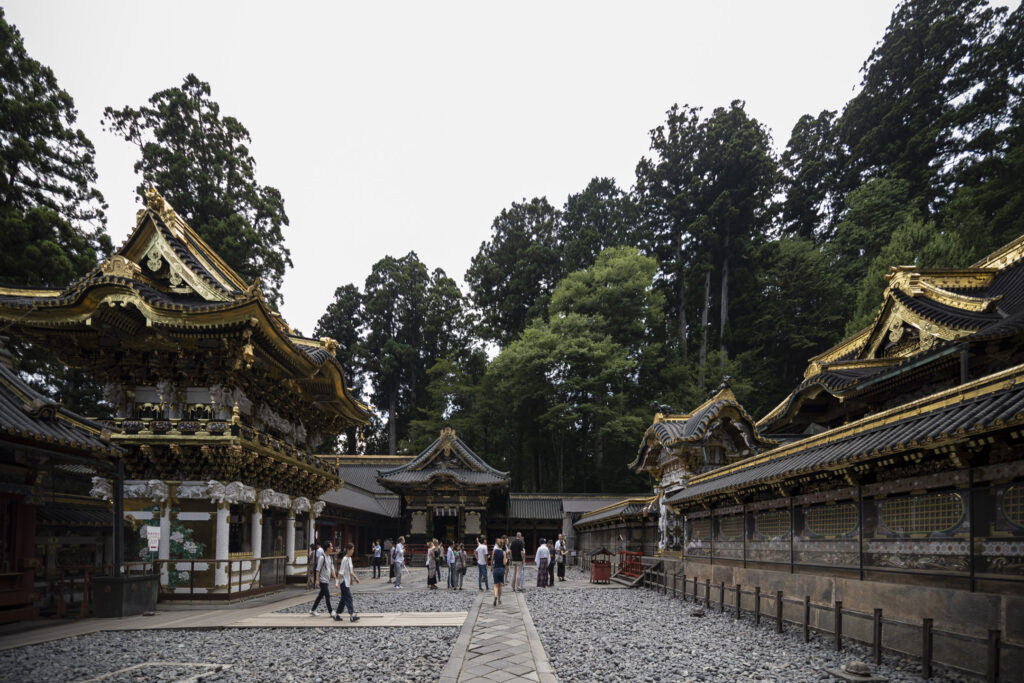
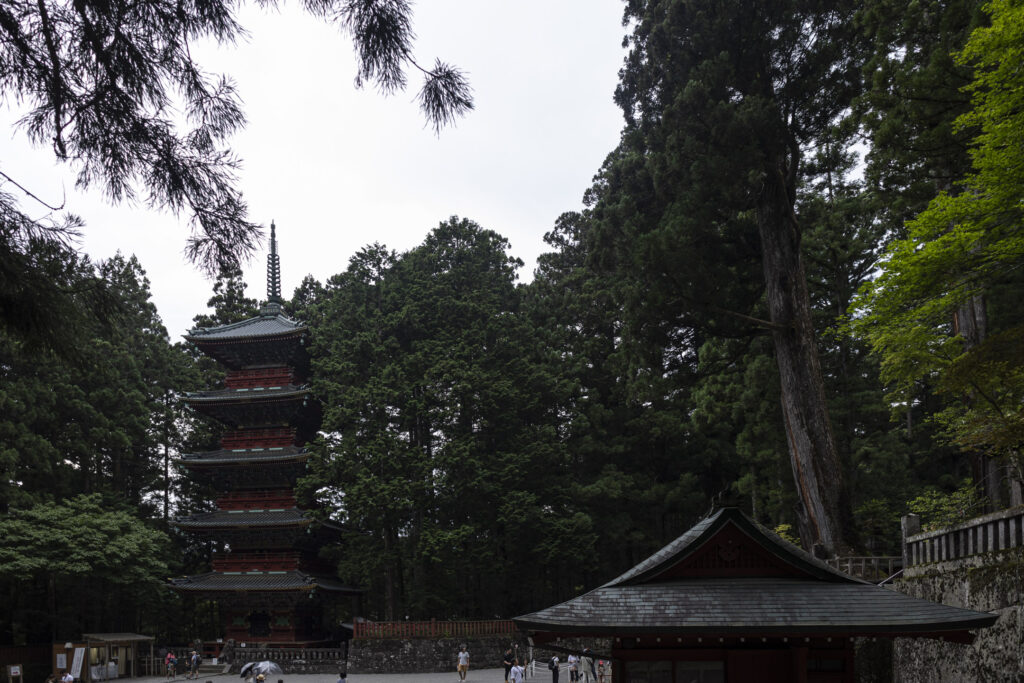
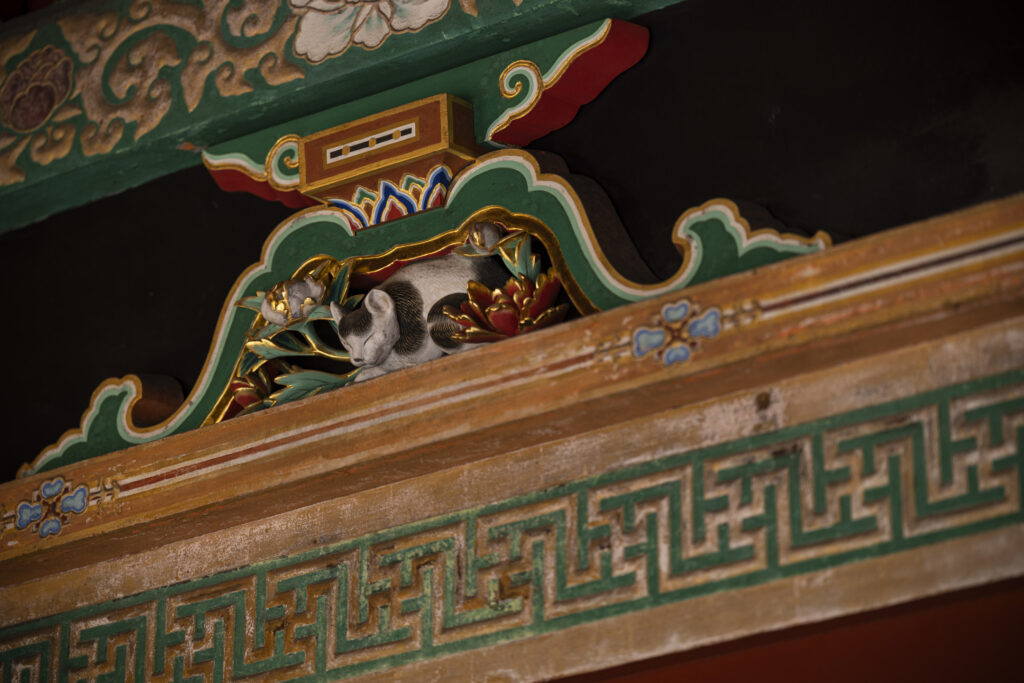

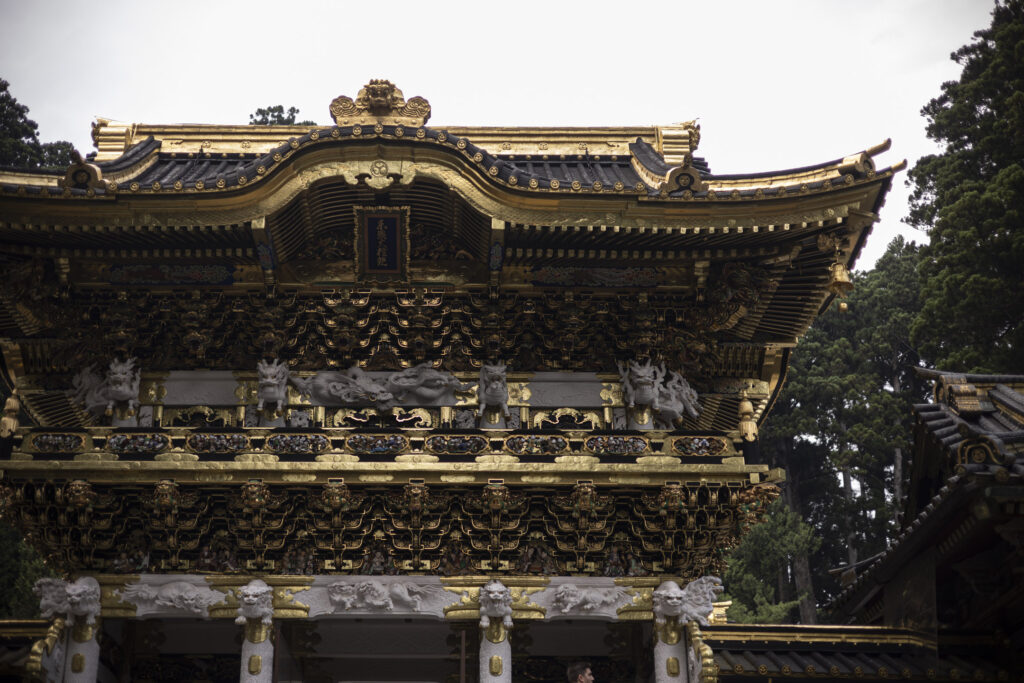
Nikko Toshogu is characterized by its use of paths and stairways that take advantage of the natural topography, and the well-balanced arrangement of the shrine pavilions, which create a solemn religious space. The buildings are decorated with lacquer and rich luxuriant colors, and the pillars are adorned with numerous carvings, which are not mere design elements, but rather expressions of religious expression, philosophies, and folklore.
Ishidorii (stone torii gate) (Important Cultural Property).
The gate was dedicated in 1618, the year after the shrine was built, by Nagamasa Kuroda, feudal lord of Chikuzen, Kyushu (Fukuoka Prefecture). The stone was first transported from Kyushu to Oyama by boat, and then to Nikko overland by hand.
Goju-no-To (five-story pagoda) (Important Cultural Property)
The pagoda was dedicated in 1650 by Tadakatsu Sakai, lord of the Obama domain in Wakasa Province (Fukui Prefecture). It was destroyed by fire in 1830, but was rebuilt shortly thereafter.
Omote-mon Gate (Important Cultural Property)
Omote-mon Gate is the first gate of Toshogu Shrine, and is also called Niomon because of the fierce Nio statues on each side.
Sanjinko (Three Storehouses) (Important Cultural Property)
The upper, middle, and lower storehouses are collectively called the Sanjinko, and they house the horse harnesses and various costumes used in the “Hyakumonotorei Senjin Samurai Procession,” a spring and fall procession festival.
A large sculpture of an “imaginary elephant” (a Kano Tanyu sketch) is carved under the roof of the upper shrine building.
Shinkyusha Sanzaru (Three Monkeys) (Important Cultural Property)
The sacred stable is for sacred horses. Since monkeys, from ancient times in China, have been believed to protect horses from disease and accident, there are eight sculptures of monkeys on the long posts, satirizing the life of human beings. The stable monkeys are called “umayagami”, or “gods of the stable”.
The most famous of these sculptures in Nikko is the image of the three monkeys who, “see no evil, speak no evil, hear no evil”.
Omizuya (Water House) (Important Cultural Property)
This building is used for visitors to wash their hands, rinse their mouths, and purify the body and mind before paying homage to the gods. The water basin was dedicated in 1618 by Katsushige Nabeshima, lord of the Kyushu-Saga domain.
Yomeimon Gate (National Treasure)
This is the the most beautiful gate representing Japan and its cultural traditions. It is also called by many the “Gate of Dusk” because one will never tire of looking at it and can stand in its presence for a full day. It is decorated with more than 500 carvings of stories and fable, saints and wise men, folkloric characters, and spiritual creatures.
Corridor (National Treasure)
The outer walls are decorated with some of the largest carvings of flowers and birds in Japan. Each carving is made of a single plate, and decorated in rich vibrant colors.
Karamon Gate (National Treasure)
The entire gate is painted white with “gofun”, a particular tone that is created from seashells, and is decorated with detailed carvings such as “Kyoyu and Soho”, two Chinese sages and “Shuntei Choken no gi” (Emperor Shun’s morning greetings), complete with four rows of 27 figures carved out of a single zelkova tree.
Gohonsha (National Treasure)
This is the most important part of Toshogu, consisting of the main hall called “Honden”, the “Ishinoma” (stone chamber), and the “Haiden”, the hall of worship. Annual festivals and other ceremonies are held here. On either side of the hall of worship are the “Shogun’s Chamber” and the “Prince’s Chamber”.
Shinyosha (portable shrine) (Important Cultural Property)
Three portable shrines used for the spring and fall processions (May 18 and October 17) are housed here. Sacred processions are conducted in May and October.
Prayer Hall, called “Kitodan” (Important Cultural Property)
Prayers for weddings, first visits to the shrines, blessings of newborns, and other celebratory ceremonies are held here.
Sleeping Cat (National Treasure)
It is said to have been made by Jingoro Hidari. It is said that the cat was carved in reference to “Nikko” (sunlight), as it is surrounded by peony blossoms, basking in the sunlight and dozing off.
Okumiya (Important Cultural Property)
The Okumiya is a shrine for the entombed deity, consisting of a hall of worship, an Inukimon gate, and a pagoda.
Homotsukan (Treasure House)
A property to house treasures and significant artifacts.
Butoku-den (Hall of Butoku) (Registered Tangible Cultural Property)
A special and sacred place for the preservation of, and active development and maintenance of martial arts.
Guest Hall and Shrine Office
The guest hall and shrine office are widely used as a facility for welcoming visitors, prayer services, and festival services. This office also can facilitate tea ceremonies and mini-concerts.
Futarasan Shrine
In the year 782 this shrine was founded by a Buddhist monk named Shodo Shonin. At that time, Shinto and Buddhism were closely entwined. This shrine is dedicated to Nikko’s three sacred mountains: Mt. Nyoho, Mt. Taro, and Mt. Nantai. The name “Futarasan” also carries the same meaning as “Mt. Nantai”, which is considered the greatest of the three. Shodo Shonin also founded the nearby Rinnoji Temple.
The shrine has three distinct sections, so there is much to see an explore. The main shrine is between the Nikko Tosho-gu and the Taiyu-In Mausoleum. The next shrine is on the shore of Lake Chuzenji, and the highest, most sacred center of the “inner shrine” is at the peak of volcanic Mt. Nantai.
Futarasan is also a UNESCO World Heritage Site, particularly for its uniquely shaped “hip and gable” roofs. Visitors to Futarasan often come with prayers for happiness in marriage and fertility. While not as ornate as other shrines in the region, Futarasan is deeply spiritually significant as a worship site for the three holy volcanic mountains of the region and has Mt. Nantai as its backdrop. Each day shrine attendants perform the “kagura”, sacred dances to the Shinto deity, Onamuchi-no-Mikoto, the god of nation building and medicine. Within the Futarasan Shrine Museum we can find a collection of swords, as well as Japan’s longest sword called “Nenekirimaru”. The museum contains other national treasures to view as well.
The goddess, Ukanomitama-no-Kami is another Shinto deity that is celebrated here at the Chugushi Inari Shrine, also found on these grounds. This goddess is worshipped by those seeking a good harvest, or to secure success in business.
Futarasan is also home to one of the three most beautiful bridges in all of Japan. This vermillion lacquered bridge has two names. One is “Shinkyō”, or “Sacred Bridge” and the other is “Yamasugendo-jabashi” which means “Snake Bridge of Sedge”. Legend has it that at a time when Shodo could not cross the Daiya River due to its strong current a ten-foot tall god named Jinja-Daiou appeared. The enormous god had two snakes around his right arm, one red and one blue. Jinja-Daiou released the snakes and they changed into a rainbow bridge covered with sedge allowing Shodo and his group to cross safely.
Futarasan is a large sprawling area with many buildings, statues, and gates. Take time to wander through these sections nestled in their forest spaces and enjoy the sights and sounds that surround this sacred place.
-1-1024x683.jpg)
-1-1024x768.jpg)
-1.jpg)
Rinnō-ji Temple
As we enter the temple grounds called Rinnō-ji, we come to a very holy building that houses three key Buddhas. The building is called, “Sanbutsudō, which means “Three Buddha Hall”. Within we find the sacred images of Amida, the Pure Land Buddha of pure perception, Senju Kannon, the goddess of mercy with a thousand arms, and Batō Kannon, the “Kannon with a horse’s head, the god of wisdom and knowledge. These three deities are the Buddhist manifestations of Nikko’s three mountain “kami” (gods) that we find at Futarasan Shrine. The parallels between Shinto and Buddhism are found complete between these two spiritual streams.
Also on these temple grounds we find a lovely garden called, “Shōyō-en”, that was created by a Confucian scholar named Issai Sato. Within the pond are carp, and the area is adorned with stone lanterns, a pagoda, and lined with bamboo fences. There is also a rustic tea house as well. This garden is said to be designed to take the shape of Lake Biwa of Shiga Prefecture. Rinnō-ji is a treasure trove of Buddhist art, documents, scrolls of sutras, and many other historical and cultural items. A good number are often on display for us to explore and enjoy. As the temple that maintains the mausoleum of Tokugawa Ieyasu, Rinnō-ji is particularly important and considered one of the most significant Buddhist temples in all of Japan.
-1-1024x683.jpg)
